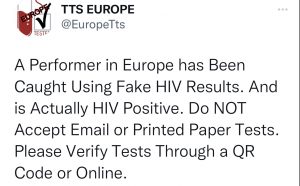Even in countries that have made great gains in reducing the burden of AIDS, the epidemic is still growing among gay men.
By Alice Park
As the world’s leading AIDS researchers gather for the International AIDS Conference in Washington, D.C., scientists report that despite gains in controlling the spread of HIV, the disease has continued to spread at an alarming rate in the very population in which it first appeared — gay men.
In a series of papers in the Lancet dedicated to the dynamics of HIV among gay men — a group epidemiologists define as men who have sex with men (MSM) — scientists say that the continued burden of AIDS in this group is due to a combination of lifestyle and biological factors that put these men at higher risk. Rates are rising in all countries around the world.
In one study, led by Chris Beyrer, of the Center for Public Health and Human Rights at the Johns Hopkins Bloomberg School of Public Health, researchers analyzed surveillance reports and studies of HIV among MSM, including data that were part of routine United Nations reporting from member nations. Rates of HIV among gay men ranged from 3% in the Middle East to 25% in the Caribbean. In all reporting nations, rates were on the rise, even in developed nations like the U.S., Australia and the U.K. where HIV is declining overall.
In fact, says Beyrer, income does not seem to matter when it comes to HIV trends among MSM. In the U.S., for example, infection rates among gay men have been increasing by 8% each year since 2001, contributing to a 15% prevalence rate and putting the U.S. on par with countries like Thailand, Malaysia and some African and Caribbean nations where neither awareness of HIV/AIDS nor drug treatments are as widespread. HIV prevalence rates among MSM in Brazil, Canada, Italy and India range between 11% and 15%, while many western European countries have lower rates of around 6%.
Public health experts have been concerned about the rising rates among MSM for years now, viewing the current epidemic as the second wave — the first having occurred in the 1980s. Today’s infections, they say, are affecting a new generation of men who didn’t live through the initial devastation of AIDS’s early days, when there were no drug treatments and a diagnosis was a death sentence. Public health messages about safe sex practices and testing targeted to gay men have waned in the intervening years, and now, some experts say, a new generation of at-risk men have to be educated about the disease.
HIV has always been more common among gay men, but Beyrer and his colleagues say the traditional risk factors may not entirely explain the surge in many cases. Traditionally, HIV experts have pointed to high-risk behaviors such as unprotected sex, having multiple partners, injection drug use and drug use in general for making gay men more vulnerable to infection. But there may be biological reasons for the enhanced risk as well. For example, there is an 18 times greater risk of HIV transmission through anal sex than through vaginal sex, which may explain why the virus continues to thrive in gay men, despite the fact that they still receive the bulk of HIV awareness and treatment public-health messages. “If HIV infection in MSM is heavily biologically determined, do present approaches to HIV programming for MSM, which rely heavily on information, education and behavior change strategies, make sense?” the authors write. “The epidemiology suggests that urgent reform is needed.”
That’s why the latest data on using HIV treatments to protect healthy people from infection, a strategy known as pre-exposure prophylaxis (PrEP), are of particular interest to public health experts. In another paper in the Lancet series, researchers estimate that about 25% of new infections among MSM might be avoided if prevention practices such as PrEP could be combined with existing strategies, such as safe sex counseling and condom use.
But the key to making these efforts work is in bringing the health care community on board. In another paper in the series, researchers document the fact that many health care providers aren’t trained or equipped to screen, treat or advise gay men about their HIV risk. In some countries, stigma about HIV continues to thwart physicians’ ability to provide adequate care to MSM at risk of infection. “Optimum clinical care for sexual and gender minorities is a fundamental human right, and the support of health care professionals is needed for its provision,” write the authors.
Source: Time Healthland







